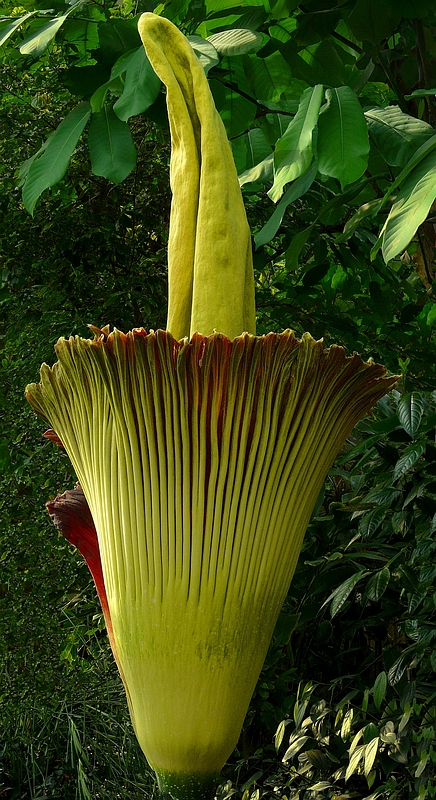Exotic Beauty (50) : Titan Arum
The past years I made several visits to the conservatories of the National Botanic Garden of Belgium where 10.000 (!) plant and tree species originating from the tropics and the subtropics are growing in the greenhouses over there.
Thanks to the warm and moist climate in the conservatories and the intensive maintenance, it’s really amazing what an immense great variety of exotic flowers from all over the world can be seen there, even in the cold winter season !
Flowers whose natural habitat is situated in the rainforest, the mountain forest, isolated islands, deserts, etc……. Places that most of us will never or seldom visit.
Some of the flowers are very rare, extremely colourful or specially shaped.
Others were introduced in Europe by men and became a cultivated species or an ornamental houseplant.
I selected the –to my personal taste- most beautiful flowers that I saw there and made a series of them.
******************************************************************************************
In English also known as Corpse flower
Dutch name : Reuzenaronskelk
German name : Titanenwurz
Latin name : Amorphophallus titanum
Country of origin : rainforest of Sumatra, Indonesia
***
Not really an exotic beauty, I fully agree, but very special this one : it’s the BIGGEST flower in the world that can reach 3 metres in height !
(the specimen that I shot was 2,32 meter high)
A Titan Arum coming into flower is as rare as it is spectacular.
The plant’s blooming schedule is completely unpredictable. It usually takes 6 years (or more) for it to accumulate sufficient energy to summon the power to blast up a bloom.
The flower itself smells like rotting flesh of a decomposing mammal.
In the wild, this striking plant is on the brink of extinction !
The tropical rainforest of Sumatra is the only place in the world where this plant grows and there 70% of its habitat has already been destroyed due to relentless and unstoppable logging.











Maren Arndt 22/06/2013 10:40
Great.Best regards
Maren
Jacques BURY 31/01/2013 11:02
Very rare and*****Excellent*****Nordeifeler 20/01/2013 12:46
wunderschön abgelichtet,die seltene exotische Pflanze,schön in den Farben und beste Schärfe..Grüße Kai..
RicoB 20/01/2013 8:00
Wunderschön ist er und auch für die Nase ein Erlebnis, ein tolles Bild,carinart 19/01/2013 17:10
Eine solche Blüte sehe ich zum erstenmal - herrlich ist sie von dir gezeigt!L.G. Karin
DRAGA PUC 19/01/2013 16:51
++++++willy ombret 18/01/2013 20:03
splendide structure très bonne nettetéexcellents
willy ombret
aline64 18/01/2013 16:09
Très joli cette plante une belle priseAmicalement
Howard Mattix 18/01/2013 3:01
A great capture of this beauty. Excellent details and colors.I don't think I could stand the smell, it would bring back unpleasant Viet Nam memories.Kind regards,
Howard
Angelika El. 18/01/2013 0:19
Ja, es ist immer wieder ein großes Ereignis wenn die Titanenwurz zum Blühen kommt! Wir haben in Suttgart auch ein Exemplar, das immer wieder zum Blühen kommt - schade ist nur, dass der "Duft" so penetrant mies ist... Deine Aufnahme ist Klasse...
LG!
Angelika
Susanne47 17/01/2013 22:52
Fantastisch Mark, danke fürs Zeigen, sowas sieht man ja nicht alle Tage.....Grüessli Susanne
TeresaM 17/01/2013 22:00
Originale et belle présentation ! J'aime.Amitiés,
Adele D. Oliver 17/01/2013 21:01
Wow - amazing this plant - incredible what you tell us about it .... and hopefully it will go on although the smell sounds revolting !!greetings, Adele
Lawson McCulloch 17/01/2013 20:24
This species flowered a couple of years ago at The botanical gardens in Edinburgh. They had to remove some of the glass in the hothouse because of the height of the plant.best wishes,
Lawson
Deryck 17/01/2013 20:20
What a magnificent flower.... not one for my garden, but Wow! Great shot of this very interesting slowerDeryck